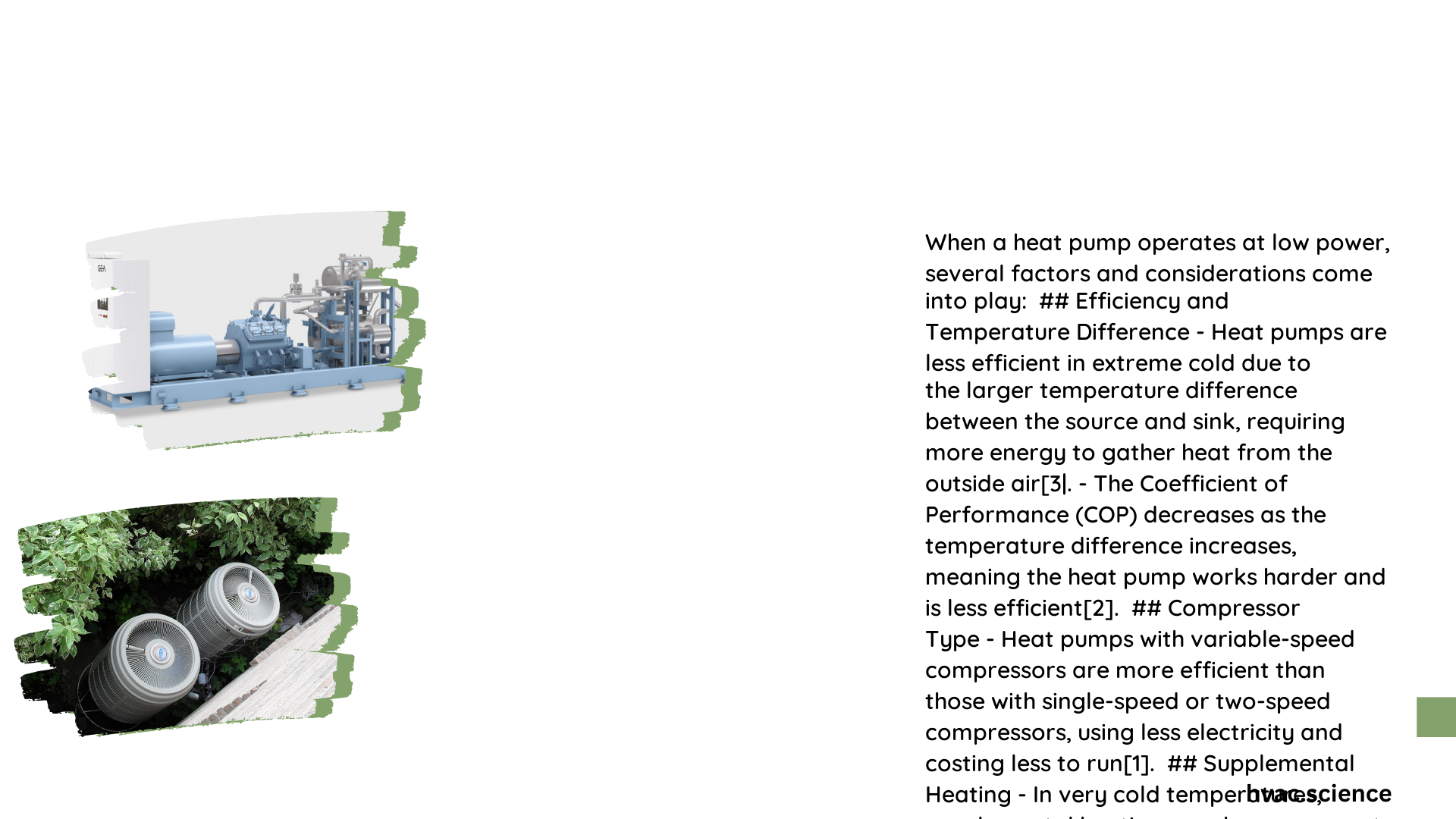Heat pump low power systems are innovative heating and cooling solutions that offer high efficiency and reduced energy consumption. These systems operate at lower capacities, typically around 17,300 Btu/h, while maintaining impressive Coefficients of Performance (COP) ranging from 2.0 to 5.4. Low power heat pumps can significantly reduce energy costs, with some models increasing seasonal performance by up to 69% in heating and 60% in cooling compared to traditional systems.
What are the Key Performance Metrics for Low Power Heat Pumps?
Low power heat pumps are characterized by their exceptional efficiency and performance metrics. Here are the key factors to consider:
- Coefficient of Performance (COP)
- Range: 2.0 to 5.4 (depending on outdoor temperature)
- Example: At 8°C, COP can reach up to 5.4
-
Low-Load Efficient (LLE) heat pumps: COP up to 4.73 during low-load operation
-
Heating Capacity
- Minimum capacity: Around 17,300 Btu/h
-
Average capacity during steady low-load operation: 19,365 Btu/h
-
Energy Consumption
- Varies based on COP and heating capacity
- Example: A heat pump with COP of 3 uses 1 kWh of electrical energy to deliver 3 kWh of thermal energy
How Do Low Power Heat Pumps Achieve High Efficiency?

Low power heat pumps achieve high efficiency through several innovative features:
-
Modulating Capacity: These systems can adjust their output to match the heating or cooling demand, reducing energy waste.
-
Advanced Compressor Technology: Use of variable-speed compressors allows for precise control of refrigerant flow.
-
Improved Heat Exchangers: Enhanced designs maximize heat transfer efficiency.
-
Smart Controls: Sophisticated control systems optimize operation based on indoor and outdoor conditions.
What are the Installation Requirements for Low Power Heat Pumps?
Installing a low power heat pump requires careful planning and specific equipment:
Necessary Equipment:
- Outdoor unit (compressor, fan, coil)
- Indoor unit (coil, fan, supplemental heat source)
- Refrigerant lines
- Thermostat
- Grounding and electrical connections
Installation Costs and Timeframes:
- Cost range: $3,000 to $10,000+ (depending on type and complexity)
- Timeframe:
- Air-source heat pumps: 1-3 days
- Ground-source heat pumps: Several days to a week or more
What Benefits Do Low Power Heat Pumps Offer?
Low power heat pumps provide numerous advantages:
-
Energy Savings: Can increase seasonal performance by up to 69% in heating and 60% in cooling.
-
Environmental Impact: Reduce CO2 emissions by up to 66% compared to electric resistance heaters.
-
Rebates and Incentives: Available rebates can range from $500 to $2,000 or more.
-
Comfort: Provide consistent heating and cooling with less temperature fluctuation.
How Do Low Power Heat Pumps Perform in Different Climates?
Low power heat pumps can adapt to various climatic conditions:
-
Moderate Climates: Excellent performance with high COP values.
-
Cold Climates: Some models, like the Acadia by Hallowell International, can operate efficiently even at low temperatures by increasing capacity in stages.
-
Hot Climates: Efficient in cooling mode, with some models offering enhanced dehumidification capabilities.
What are the Common Operational Issues and Maintenance Requirements?
To ensure optimal performance, be aware of these issues and maintenance needs:
Common Issues:
- Cycling behavior
- Temperature fluctuations
- Refrigerant leaks
Maintenance:
- Frequency: Every 6-12 months
- Tasks:
- Clean air filter
- Inspect refrigerant lines
- Check for leaks
- Monitor system performance
How Can I Troubleshoot My Low Power Heat Pump?
Follow these steps to troubleshoot your low power heat pump:
- Monitor system performance regularly
- Check for unusual noises or vibrations
- Inspect for visible damage or leaks
- Clean air filters and outdoor unit
- Verify thermostat settings
- If issues persist, contact a professional HVAC technician
What Future Developments Can We Expect in Low Power Heat Pump Technology?
The future of low power heat pump technology looks promising:
-
Increased Efficiency: Ongoing research aims to push COP values even higher.
-
Smart Integration: Enhanced connectivity with home automation systems for optimized performance.
-
Improved Cold Climate Performance: Development of heat pumps that maintain high efficiency at extremely low temperatures.
-
Natural Refrigerants: Shift towards more environmentally friendly refrigerants with lower global warming potential.
By leveraging these advanced technologies and proper maintenance, low power heat pumps offer an efficient, environmentally friendly solution for home heating and cooling needs.
